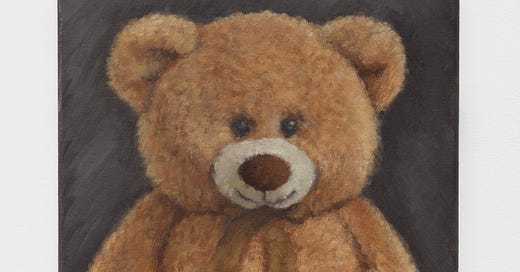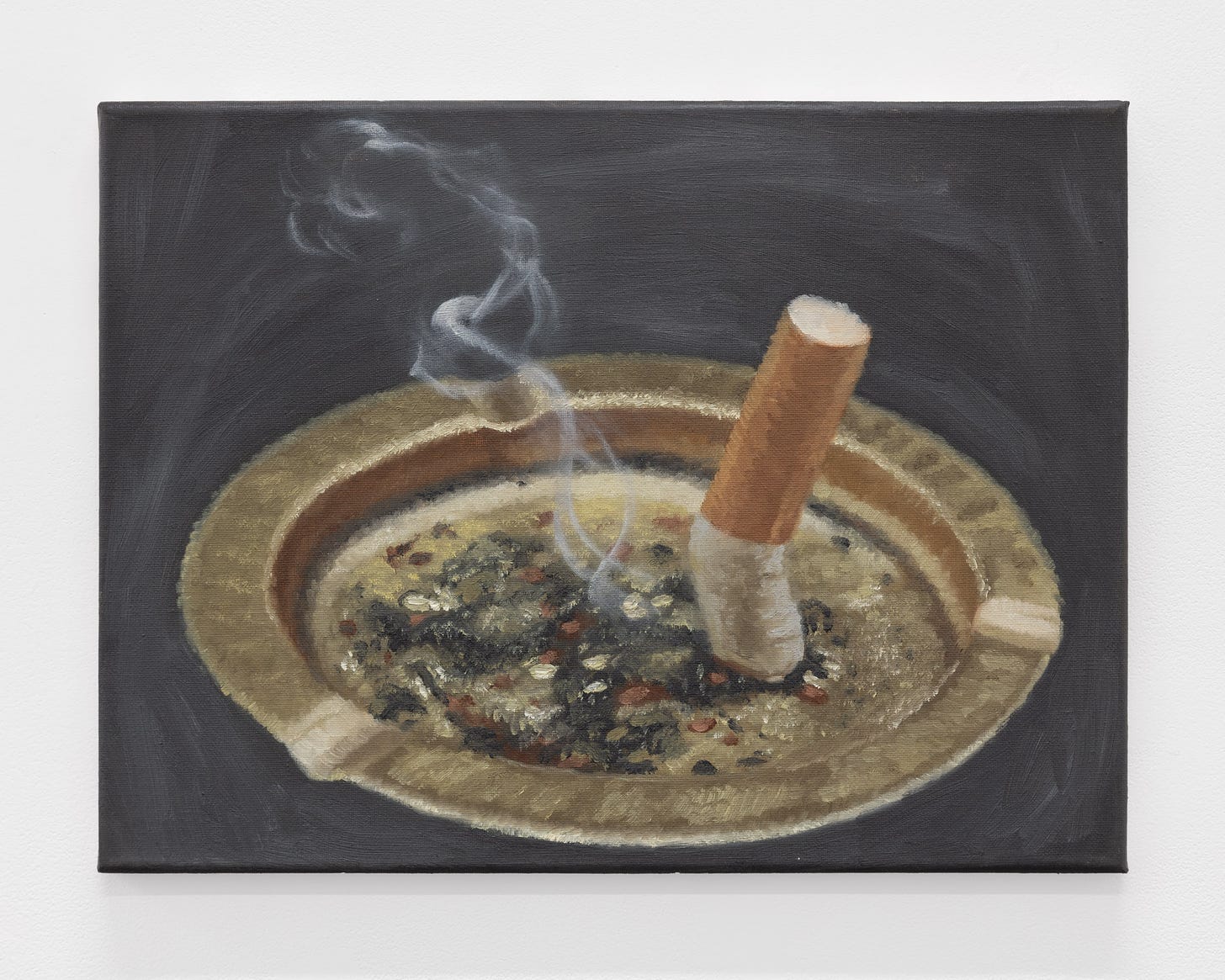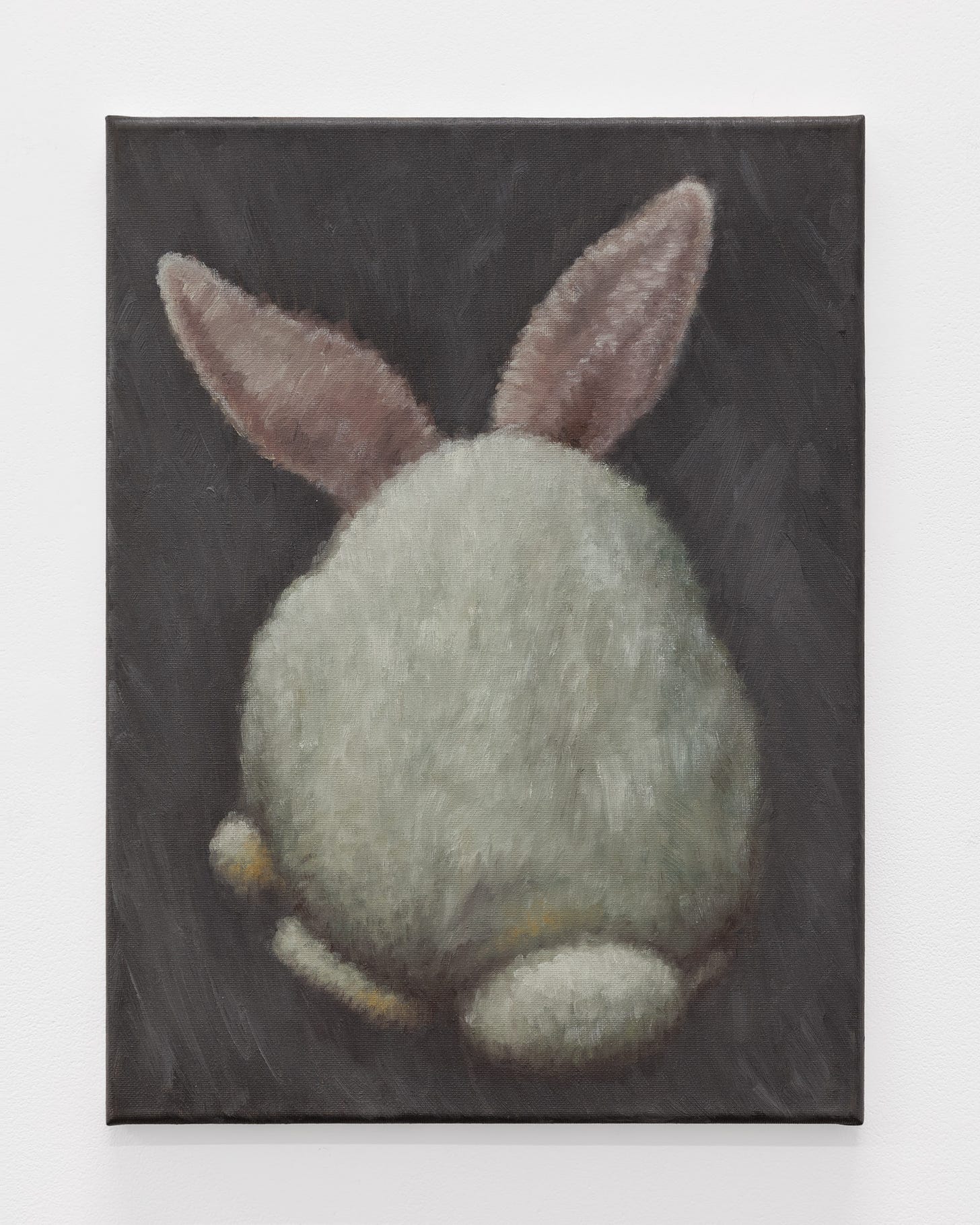Today’s newsletter is a bit different—no links, just an essay I wrote for Stephanie Ligeti’s solo exhibition at Franz Kaka, P is for Painting. The exhibition reception is tonight (Thursday) from 6:00 - 8:00 pm at Franz Kaka in Toronto. You should come.
An essay has to begin somewhere; it might as well be with the letter A. In Stephanie Ligeti’s debut solo exhibition at Franz Kaka, P is for Painting, A isn’t for Apple like it was in Kindergarten, it’s for Ashtray. The included 26 paintings each depict an object that corresponds to a unique letter of the latin-alphabet. Bread. Coffee. Dog. Eggs. Flower. Like letters written across a blackboard, the order is familiar, each icon locking into place. The paintings are anchored to their name but are also their own separate entity. I write down on a scrap of paper: THE ALPHABET IS NOTHING WITHOUT WHAT IT RELATES TO.
Before viewing Ligeti’s series, I admit I hadn’t thought much of the alphabet recently. Yet I write daily—each sentence and word in this text is compiled of their essence. The alphabet structures written language, the familiarity of it blending into everyday life until it becomes unobtrusive. By returning to the A-Z framework to build an exhibition, Ligeti creates a cohesive set from fragments. When viewed outside of this order, Ligeti’s paintings lose their abecedarian connection and instead float into the world of signs and signifiers. What is intended as a Wig could just as easily be read as Hair, and X-Ray could also be a Bone. It isn’t the letter that matters but the connotations they evoke.
Counteracting this, Ligeti’s palette and brushwork work to keep the series intact. The grayed background and desaturated hues keep the 26 paintings connected outside the imposed alphabetic parameters. If the school version of the alphabet is bright and cheery, Ligeti’s takes on a somber tone. These formal devices ground the paintings; the premise of the P is for Painting is fun and playful, but there’s also a throughline here that’s dark and composed. In person, the painterly quality of Ligeti’s works is obvious. Painted in a single sitting, alla prima, adds to the haziness of the paintings. The brushstrokes are small and purposeful.
During Ligeti’s time working on the exhibition, she was in Vienna, Austria, where she moved in 2022. Surrounded by an unfamiliar language, the alphabet series was a way to ground her in the familiar while meditating on the painting process. The ashtray, she recalls, was similar to something found at her grandma’s house growing up. The 2023 balloons, representing Y for Year, were from a calendar her Aunt sent her. Her colours reflect Vienna's infrastructure—old architecture and limited greenery. As the series continued, Ligeti repainted d earlier works in the series—the daily act resulting in stronger paintings as Ligeti went on.
Each painting in P is for Painting represents a conceptual framework focussed on process, not unlike On Kawara’s date paintings. The Japanese conceptual artist carefully painted the date; each painting started and finished on the same day. During his lifetime, he painted more than 3,000 date paintings. The paintings are unwavering commitments to the act of painting and representations of life as it unfolds. To a viewer, unintended meaning can be projected onto the dates. For example, I’ve seen hundreds of Kawara’s date paintings, but never my birthday. When I come across other dates that have special meanings, I document them with my phone.
Fragments—dates or objects—connect us. Taken from stock photography and translated into paint, the source material of Ligeti’s paintings lacks context. Yet, as icons, they can absorb the projections of the audience. The signified is different for each person, a personal history layered onto them. T is for Tatum and also for Teddy Bear. I can spell my name with the icons Ligeti chose. Teddy-Ashtray-Teddy-Underwear-Milk. An essay can start each paragraph in sequence with the alphabet. The impersonal becomes personal, just as On Kawara’s dates take on loaded meanings. Ligeti’s paintings are activated by the viewer’s associations and projections. P is for Painting. They’re all paintings, and whatever else you’d like them to be—from A to Z.
Stephanie Ligeti
P is for Painting
Franz Kaka
February 8 - March 9, 2024
Opening reception Thursday February 8, 6:00 - 8:00pm








I'm curious about this trend in painting towards dark, hazy, moody scenes of banal objects. Feels like all the young artists are painting these fuzzy scenes, whether oil or acrylic, or doing abstract type drawings and including cybersigilism, like basically chrome tribal tattoos and neopagan themes fused with aesthetics they probably were only exposed to briefly in their childhoods, but you see it everywhere now.
I get the intention of the artist, but I'd be curious for a greater overview of what is going on in painting nowadays, cuz its making me feel old haha. I just don't get the current style. like 7 years ago it was airbrush, and I could wrap my head around that because of its clear connection to digital art. But now its fuzzy blurry soft and dark paintings and I don't know where its coming from. Is it just that the 90s and 2000's are in and the kids are bringing it back and its made its way into painting? Where does the sinister vibe come from? Cuz the 90s were pretty chill.
I is for Irony? Or S is for Straight faced irony? W is for What to paint? Or Kaka's White cube? (Or is that an K? I recently read that the white cube exhibition space was an invention of Hitler's.) If Legeti's intention is to provide an object to facilitate the viewer's personal projections, the object itself hardly matters. If she had simply affixed the objects she painted to Kaka's white walls for this exercise, she would have been treading on Duchamp's toes. How does painting them change the conversation?